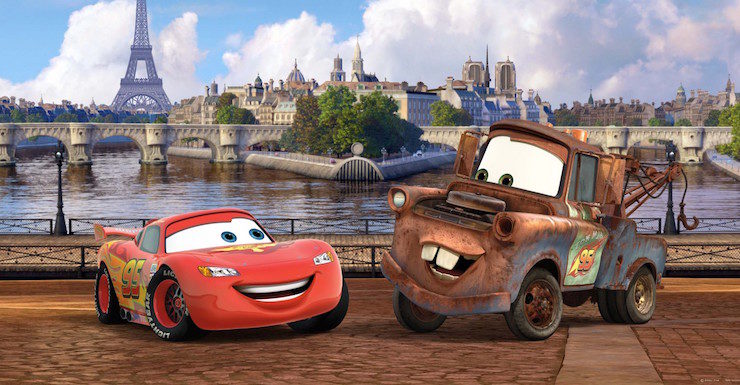Every long-term creative outpouring and effort will run into a bump at some point.
Even that of Pixar, which by Toy Story 3 had enjoyed a nearly unmatched run in Hollywood terms, and certainly in animation terms, of critically and financially successful films, interrupted by only the minor blip of Cars—which if not a critical favorite, had at least been a financial favorite.
Which came to a braking halt with Cars 2.
Which I ended up enjoying a bit more than Cars, but we’ll get there.
The success of Toy Story 2 pushed Pixar into making plans for sequels for their other particularly successful films, which in Pixar terms, meant Cars, Monsters, Inc., Finding Nemo and The Incredibles. It was a good idea, which in the case of Cars immediately drove into (sorry) a number of practical problems. Three of the original voice actors had died, including Paul Newman, who had voiced the major role of Lightning McQueen’s mentor, Doc Hudson. Replacing Newman’s unmistakable tones was a near impossible task for any voice actor. At the same time, not replacing Newman’s unmistakable tones meant suggesting that yes, the cars of Cars could die, which brings up all sorts of questions which would not, in the end, be answered by this film.

Story was another issue; main star Lightning McQueen had already had his character development in the last film, transforming from jerk to nice guy, and finding the love of his life. Radiator Springs had also transformed from a dying town of rusting cars to a vibrant tourist destination. All of this seemed to leave little story to tell.
On the other hand, small kids loved Cars and eagerly demanded Cars merchandise: not just toys, but clothing, furniture, kitchen items and more, making Cars one of the most lucrative of Disney’s franchises. So—although John Lasseter later firmly denied that anyone from the Disney marketing department had given him so much as a mere hint, a sequel did go into development shortly after Disney purchased Pixar.
The film would have at least one major change from the original. Instead of focusing on one car in one small abandoned town, Lasseter and the other animators decided that the sequel would explore the car world—the global car world—swinging by Japan, Paris, Italy, Germany and London. All, not coincidentally, happened to be places that Lasseter had visited while promoting the earlier Pixar films, and all, possibly coincidentally, seemed to be nice places for animators to go to while on “research” trips. The choice to swing around the world also gave Cars animators plenty of ideas for visual jokes—as well as the opportunity to throw in a quick visual reference to Ratatouille.
With that, the filmmakers had a background and the potential for jokes. What they still didn’t have was a story beyond “how would a couple of American cars react to this in the car world?” After some more thought, the filmmakers decided to throw in a spy plot—partly as a homage to the use of fabulous cars in multiple spy movies, but mostly to ensure that the characters had something to do. And since Lightning McQueen had already had his story, Pixar decided that this film would focus on his friend, rusted tow truck Mater—virtually a rolling example of an Ugly American in virtually all ways. With the general idea in hand, Pixar moved the film into production.
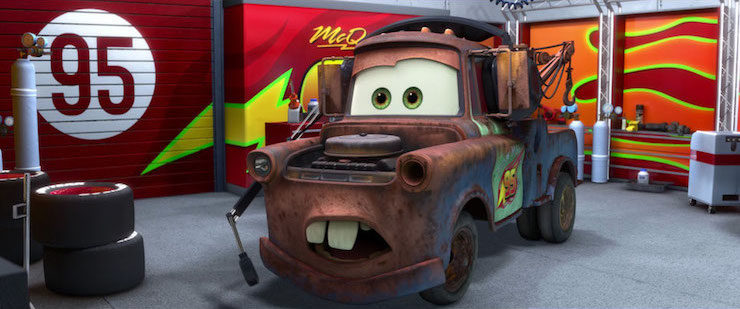
Initially, Lasseter planned to hand over the film to director Brad Lewis, who had contributed bits to previous Pixar films, produced Ratatouille (2007) and co-produced the English-language version of Ponyo. As production started running into difficulties, however, Lewis was bumped down to co-director, and eventually bumped off the film—and Pixar—entirely. Lewis ended up at rival Warner Bros, where he helped produce The LEGO Batman Movie, and then headed to Dreamworks, where, as of this writing, he is one of the producers on How to Train Your Dragon 3.
Pixar never clarified exactly what these production problems were, but it seems a reasonable assumption that costs were one major concern for still relatively new parent company Disney. The Pixar films had always been expensive, and in 2008-2010, when Cars 2 was in full production, Disney was dealing with the ever-climbing costs for Tangled, soon to receive the unenviable award of the most expensive animated film in history (although, adjusted for inflation, less than the production budgets for Disney’s Pinocchio, Fantasia and Sleeping Beauty.) Tangled and Cars 2 at least had the benefits of being attached to proven, profitable franchises, but that did not mean that Disney was completely unconcerned with production costs.
Cars 2 did, however, use that proven franchise status (as well as the benefits of not being entangled in a fairy tale) to get some financial support from various outside companies, including State Farm Insurance, despite the obvious problems with trying any type of typical product placement in an animated film about living cars. Pixar thanked the company by having Mater sing a version of the State Farm “Like a Good Neighbor” song. Still, even with State Farm’s help, Cars 2 was still expensive—probably one reason why a planned sequence set in Germany ended up getting dropped from the film.
(The other reason: the spy story ended up taking a bit more time than animators had originally thought it would, and as a film still aimed largely at small children, Cars 2 could not be too long.)
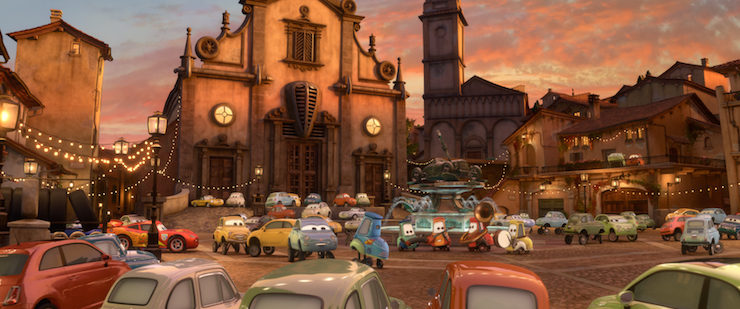
Along with the “Like a Good Neighbor” bit, the film also included references to other Pixar films, including The Incredibles and the forthcoming Brave, along with the now nearly mandatory appearance of the Pizza Planet truck, which appeared not just once, but twice. The second appearance is a “blink and you’ll it” moment rather hard to notice even on a large television set, but it’s there.
Real life color commentators Darrell Waltrip, Brett Musburger, and David Hobbs were brought in as car life color commentators Darrell Cartrip, Brent Mustangburger and David Hobbscap respectively, joined by race car drivers Lewis Hamilton and Jeff Gordon. And in one delightful bit of stunt casting, Bruce Campbell, then playing former spy Sam Axe on USA Network’s Burn Notice, was hired to voice American spy car Rod “Torque” Redline. To this, the animators naturally added a character called Prince Wheeliam, because why not add a pun to a film already overflowing with them.
(On a sidenote, I couldn’t help but feel that Prince Wheeliam’s personality seems slightly more based on Prince Charles than Prince William, but I’ve spent too long discussing this minor joke already.)
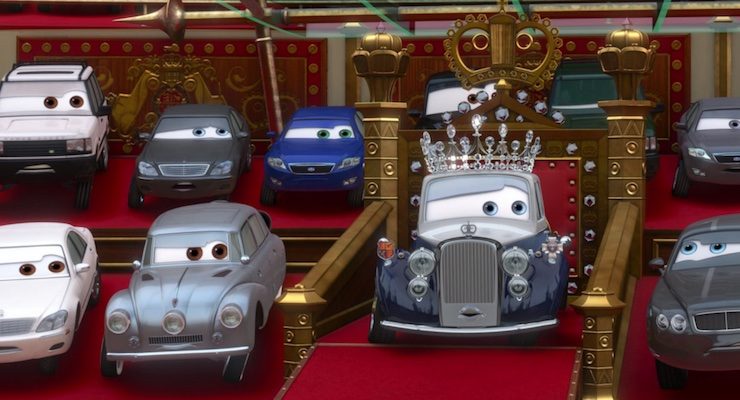
Otherwise, the voice roles were filled by returning actors from Cars, along with Michael Caine, Emily Mortimer and Eddie Izzard to provide some proper British accents for the British roles. All of these new actors and jokes, along with the shift in focus from Lightning McQueen to Mater, meant that many of the original characters/actors had little to nothing to do. Indeed, although I’m not 100% sure, John Ratzenberger’s grand total of two lines may be his shortest role in any Pixar film. Still, as with Toy Story 3, actors flocked to the film, delighted to be part of any Pixar feature.
Even this one.
I say “even this one” because, as it turned out, Cars would be one of the weakest entries in the Pixar lineup yet—and the first Pixar film to earn a negative rating on Rotten Tomatoes.
The good first: like all of the Pixar films, Cars 2 looks gorgeous, especially in the sun drenched Italian scenes, and the attention to detail is often staggering, especially in the brilliantly lit Tokyo scenes, where animators retooled the neon ads to reflect the life of cars. I don’t really think any of us want to look too closely at Pixar’s really weird ideas about car bathrooms—although I have questions, and many of them—or ask too many questions about the size of Big Ben in the car world, although, again, I have questions, and many of them (along with the observation that the Big Ben sequence worked a lot better when we first saw it in The Great Mouse Detective, along with the further note that the Big Ben sequence in The Great Mouse Detective used some computer assisted animation, creating a rather nice tie here between traditional hand animated art and computer animation… and I’ve gone completely off topic here again. My apologies.)
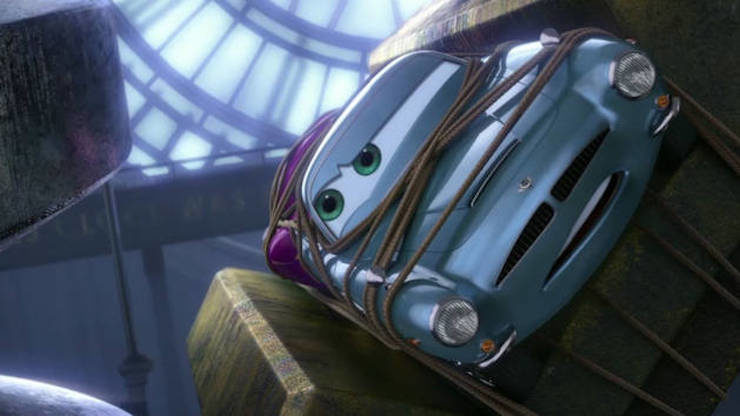
And then, the bad, much of which has to do with that plot, which splits its time between a spy caper that involves various British spy cars investigating something going on in the car world involving cameras—a something that just might involve the races Lightning McQueen has agreed to race—and the evolving friendship between Lightning McQueen and Mater.
The spy plot is by far the most fun, but starts running into issues right off the bat, like, given that the spy car (voiced by Michael Caine) can swim and turn into a submarine car, why exactly did he head to the oil rig on a rather visible tug boat? The answer, so that Pixar could throw in a cameo from Sig Hansen, is not entirely satisfactory—even if it does help convince me that yes, these British spy cars are the unthinking sorts who would mistake rusted hillbilly tow truck Mater for a spy. A spy more competent than they are, at that—which, given that they are the sorts of spies who overdo things, is perhaps not all that surprising.
But for all of its multiple issues, at least that plot is amusing, which is more than I can say for the parts of the film focusing on the friendship between Lightning McQueen and Mater, scenes which range from dull to cringe-worthy to both, except for the parts that involve the British spy cars, all of which left me squawking MORE SPY CARS WHY ARE THE NON SPY CARS STILL TALKING ANYWAY GO AWAY LIGHTNING AND MATER WE WANT SPY CARS which is perhaps not the best response to have to the two main characters in the franchise. Not to mention that by the end, I was left pretty much where I was at the end of the first film: still unconvinced that Lightning and Mater would be friends, or even should be friends, and—not to repeat myself too much—wishing that the film had spent more time on the spy cars, or even on the villain.
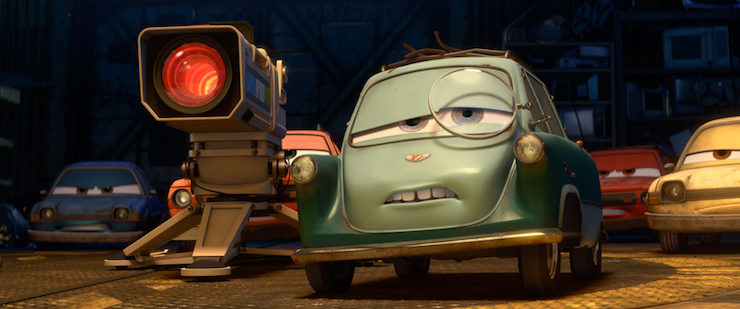
Speaking of that villain, alas, it’s really not a surprise to find out that yes, Cars 2 has one of those seemingly kindly older benevolent types who, naturally, turns out to be a villain—something that even then was becoming perilously close to becoming a Pixar cliché. It’s not even remotely a coincidence that most of the Pixar films generally listed among their best don’t have this stock villain, Toy Story 3 aside, and it’s a particular problem here when that benevolent villain is a car.
And still speaking of that villain: I have to admit that I was mildly alarmed that the supposed environmentalist attempting to introduce clean, non-oil based fuels to the car world turned out to be the villain—a reveal only slightly mitigated by the later reveal that Lightning McQueen has won all of his races while (unknowingly) using an organic fuel created by his friends.
But my real uneasiness stems from the message of tolerance and “your friends have to change, not you!” message at the end of the film. Oh, it’s not that I’m against messages of tolerance, or the message of finding healthy friendships with people who accept you as you are. But in this particular case, some of the things that Mater has done genuinely are unacceptable—with Lightning McQueen absolutely right to speak up. It’s all filmed to encourage us to feel sorry and sympathetic to Mater, and yes, in one case Mater wasn’t at fault. But Mater did screw up Lightning McQueen’s Tokyo race. Sure, it’s sorta played as one of those great big misunderstandings—Mater, told to watch the race and give Lightning tips, telling him when and when not to pass other cars, for instance, ends up getting tangled up in Spy Car business instead. And naturally, Lightning, completely unaware of the Spy Car stuff, takes Mater’s shouts at other cars as instructions to him. It’s all mostly understandable—until you remember that Lightning is actually questioning Mater at the time, and that Mater, despite realizing and hearing that Lightning is listening to him, fails to break off their communications, costing Lightning the race. This is a big deal.
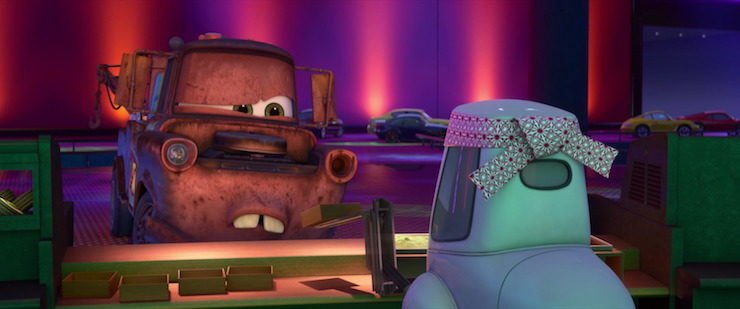
The wasabi scene, too, is fairly awful—played for laughs, the scene nonetheless shows Mater refusing to listen to local advice, overindulging in wasabi, and as a result, ruining a moment meant to honor Lightning. (Also, WHY ARE CARS EATING WASABI? EVEN OIL BASED WASABI? THEY ARE CARS! IT’S BEEN FULLY ESTABLISHED THAT THEY ONLY EAT GAS AND OIL!) It’s a horrible Ugly American moment, one of many, where Mater isn’t just insensitive, but outright rude and obnoxious, with the spy cars being the only thing stopping Mater from offending just about every car outside of the United States.
Which makes the film’s last moments of “everyone should just accept Mater for who he is!” along with Mater ending up with the girl and approval from no less than Sir Michael Caine, not to mention the “I shouldn’t have judged you!” feel at best uncomfortable, at worst, outright wrong.
Uh, no.
Yes, Mater does help save the day in the end, and yes, that embarrassing oil spill was not his doing, yes, given that he’s never lied to his friends before, they probably should have at least tried to listen to his stories of Car Spies, however improbable. But that doesn’t erase the fact that Mater, not Lightning McQueen, is in the wrong here. And yet, Lightning is the one to apologize.
Twitch.
Despite all this, I ended up liking Cars 2 more than Cars—a minority opinion, I realize. But by this film, questions about car bathrooms, car wasabi, and cars choosing to travel inside sentient planes which is just weird if you try to think about it, and I try not to, I felt a bit more accepting of the frequently questionable worldbuilding. And as said, the film looks great.
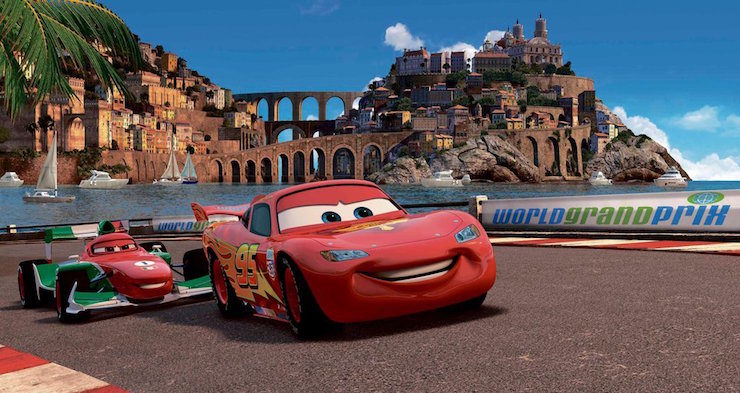
And, well.
Spy cars.
Many, many people disagreed with me. Cars 2 was Pixar’s first critical failure. Some of the criticism, to be fair, had nothing to do with the film itself, but rather the MPAA’s decision to smack a G rating on a film that includes a car getting tortured and several other cars experiencing possible permanent damage, or even, gasp, death in a major race accident, a decision that upset parents and a few film critics alike. It was not the first, or the last, time that the MPAA had been accused of slapping a G rating on an animated film just because it was an animated film, but this was one of the few times when the MPAA admitted that it—possibly—had gotten the ratings wrong. Later Pixar films, like some previous Disney and Dreamworks animated features, finally started receiving the “MAY NOT BE SAFE FOR TODDLERS” PG rating.
The rest of the criticism, however, focused on issues with the story, the ongoing weirdness with the worldbuilding of the Cars franchise, and the film’s relative lack of what, for lack of a better word, can be called charm—another negative side effect of focusing so much on the character of Mater.
That critical response may have been responsible for the slight—very slight—tumble that Cars 2 took at the box office. Overall, Cars 2 earned a respectable $562.1 million worldwide, enough to cover its budget, and an improvement over the $462.2 million the first film had earned. But it was also a significant drop from the $1 billion brought in by Toy Story 3, or the $735.1 million earned by Up. Those box office receipts were also helped by strong merchandise sales for multiple products: small children, at least, had no issues with the story or with Lightning McQueen, and still wanted to sleep on Cars sheets and wear Cars slippers. Disney had certainly survived worse disasters, and their decision to purchase Pixar continued to look like a good one.

But for the first time, the Pixar brand had been—how to put this—tarnished. Morale at the company took a hit. And now, they were about to be truly dragged into the Disney umbrella, with their first Disney Princess film.
Brave, coming up next month.
Mari Ness lives in central Florida.










